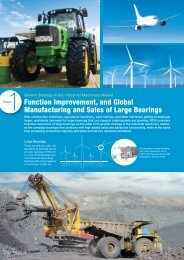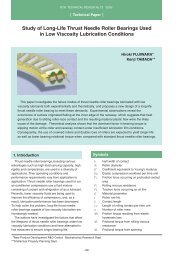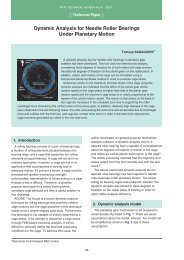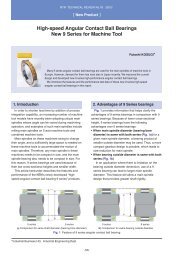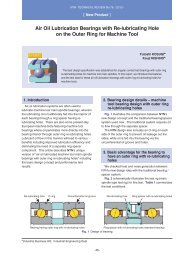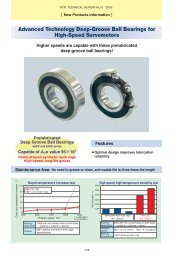Special Issue; Products for Industrial Machinery - NTN
Special Issue; Products for Industrial Machinery - NTN
Special Issue; Products for Industrial Machinery - NTN
Create successful ePaper yourself
Turn your PDF publications into a flip-book with our unique Google optimized e-Paper software.
"Hybrid Bearphite" a Sintered Metal Sliding Bearing Inserted with Plastic<br />
Fusing section<br />
Photosensitive<br />
drum bearing<br />
Developing section<br />
bearing<br />
Paper stock travel<br />
Transfer section<br />
bearing<br />
Transport roller<br />
Transfer belt<br />
Photosensitive drum<br />
Toner cartridge<br />
Imaging<br />
Imaging<br />
Imaging<br />
Imaging<br />
Fig. 1 Schematic of copying machines and printers<br />
<strong>for</strong> resin bearings, used in this type of application, can<br />
have disadvantages. During the molding process, their<br />
shrinkage rate and coefficient of linear thermal<br />
expansion are large and, as a result, their dimensional<br />
accuracy and stability are poor.<br />
Mechanisms, such as the photosensitive drum<br />
whose running accuracy greatly affects print quality,<br />
incorporate rolling bearings because rolling bearings<br />
boast better functionality even though they are<br />
relatively expensive. Concequently, there has been a<br />
growing need <strong>for</strong> a bearing suitable <strong>for</strong> this application<br />
that are both less expensive and more accurate.<br />
3. Development of Hybrid Bearphite<br />
3.1 Concept <strong>for</strong> the newly developed bearing<br />
To satisfy the needs described in Section 2 , we<br />
developed the Hybrid Bearphite, based on a concept<br />
that consists of the following parts. 1) An insert<br />
molding technique is used to <strong>for</strong>m a thin resin layer on<br />
the inner bore surface of a metal backing to achieve<br />
better dimensional accuracy. 2) The metal backing is<br />
made of sintered metal alloy to ensure effective<br />
bonding to the resin layer due to its anchoring effect.<br />
3) The resin layer is made of a low friction sliding<br />
material so that the rotational torque with the bearing<br />
is low. The newly developed Hybrid Bearphite bearing<br />
is schematically illustrated in Fig. 2.<br />
A resin layer <strong>for</strong>med inside the bore surface of a<br />
metal member will usually develop peeling on the<br />
metal-resin interface due to shrinkage occurring from<br />
molding operation with the resin.<br />
With our Hybrid Bearphite sliding bearing, however,<br />
the resin material is allowed to fill the pores in the<br />
sintered metal so that the resultant anchoring effect<br />
helps prevent the resin layer from peeling off the metal<br />
Sintered metal alloy<br />
Resin sliding material<br />
Fig. 2 Concept of HYBRID BEARPHITE<br />
backing. At the same time, through improvement of<br />
the insert molding process, the thickness of the resin<br />
layer is regulated to 0.25 mm so that the resin layer<br />
features good dimensional accuracy and the<br />
dimensional stability of the resin layer is high relative<br />
to temperature variation. If the end faces are each<br />
provided with a resin layer, then the sliding bearing<br />
can bear not only a radial load but also an axial load.<br />
3.2 Development of resin sliding material<br />
Since the main purpose of the Hybrid Bearphite<br />
sliding bearing is the replacement of rolling bearings,<br />
the friction on its sliding surface needs to be low.<br />
However, the friction coefficient of any conventional<br />
resin sliding material is 0.1 or higher, 2) so such a<br />
material would not serve <strong>for</strong> this sliding bearing. To<br />
address this problem, we attempted to develop a new<br />
resin sliding material with a friction coefficient half that<br />
of conventional resin sliding materials.<br />
The friction-wear characteristics of a resin are<br />
usually improved by blending in oil or a solid lubricant<br />
such as polytetrafluoroethylene (PTFE) or graphite.<br />
-109-




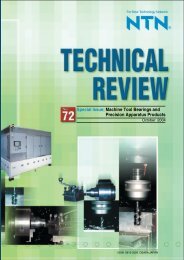
![[New Product] Unit Products for Office Equipment - NTN](https://img.yumpu.com/27154451/1/184x260/new-product-unit-products-for-office-equipment-ntn.jpg?quality=85)
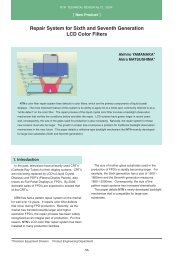
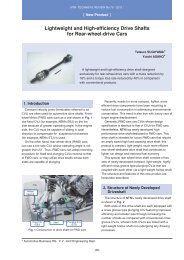
![[New Product] Development of Oil-impregnated Sintered ... - NTN](https://img.yumpu.com/27154427/1/184x260/new-product-development-of-oil-impregnated-sintered-ntn.jpg?quality=85)

